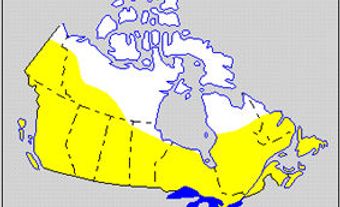
The goose is a member of a widespread group of waterfowl ranging in size from the giant Canada goose (Branta canadensis maxima) to the diminutive cackling goose (B. c. minima). The term goose is applied to many species of waterfowl in the Southern Hemisphere, but the only true geese are found in North America, Europe and Asia.
Geese belong to 2 main groups, true geese (genus Anser) and Brant geese (Branta). Some taxonomists subdivide geese into additional groups, eg, Hawaiian goose or nene (Nesochen), emperor goose (Philacte) of Alaska, bar-headed goose (Eulabeia) of Tibet and India, or snow goose (Chen). Their taxonomy at the specific and subspecific level is very complicated, especially in the races of the Canada goose and bean goose (Anser fabalis).
There are 7 species of geese in North America, 5 of which breed in Canada. Most species breed in the Boreal Forest and Tundra. Geese in Canada are intermediate in size between swans and ducks.
The Canada goose may have as many as 50 distinct races and variations, ranging in size from the cackling goose of Alaska (1 kg) to the Canada goose of Manitoba (10 kg); all have the same general pattern of black neck and head with a white throat patch.
Brant geese (B. bernicla) are divided into 4 populations: those from the eastern Queen Elizabeth Islands winter in Ireland; those from the western Queen Elizabeth Islands in Puget Sound and the lower BC mainland; those from the coastal tundra of Nunavut in Baja California, Mexico; and those from Foxe Basin off the coast of New Jersey.
The greater white-fronted goose (A. albifrons) is circumpolar, breeding in the arctic tundra.
Snow geese (Chen caerulescens) breed in the High Arctic and Ross's geese (C. rossii) in the Low Arctic.
Geese are believed to mate for life. Males are called ganders; juveniles, goslings. Members of various species may nest singly or in colonies. Usually 3-6 eggs are laid (range 2-9) in a nest of plant debris, moss, etc, lined with down. Both parents care for the young.

 Share on Facebook
Share on Facebook Share on X
Share on X Share by Email
Share by Email Share on Google Classroom
Share on Google Classroom








